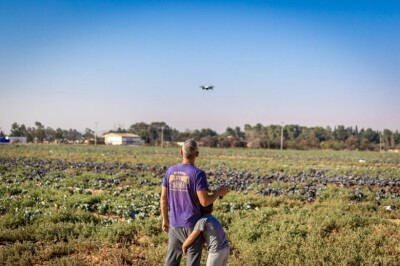The 2019 FAA UAS Symposium featured numerous insightful panels and discussions, but the “Doing Business in the Drone Age” session was particularly informative. Diana Cooper, Greg Agvent, Jennifer Richter, Brendan Schulman and Eric Schwartz discussed a wide range of topics around how they’ve helped tackle challenges associated with the drone market while also making a bottom line impact for their company or customer.
Schulman is the Vice President of Policy & Legal Affairs at DJI, and he explained that doing business in the drone age is really about the policy outcomes that flow from issues like safety and privacy. These are the things that have to be solved to ensure that policy outcomes don’t impede business. However, doing business in the drone age is also a question of public perception, and there are issues when it comes to negative stories and narratives outweighing all of the positive ones.
To illustrate that point, Schulman pulled out the
Sky Police Drone Chase Lego set, which includes a criminal trying to capture a statue with a drone. Kids can “capture the drone before it escapes with the golden statue!” That narrative is in addition to headlines like the one that confirmed an airliner said to have been hit by a drone last December
was actually damaged when a poorly done repair on the plane
only receiving 1/1000th of the attention of the original story.
Schulman discussed what DJI is doing to counteract these narratives. The company recently released its “Elevating Safety” whitepaper. The paper
describes 10 steps that must happen in order to assure drone safety, and protect drone innovation. These insights stem from DJI’s commitment to
install airplane and helicopter detectors in new consumer drones. Real collisions that have happened with helicopters at low altitudes, so what can the industry learn from these facts? ADS-B will enable airspace awareness in a big way and prevent collisions.
The business cases flow from what the policy allows you to do, and today they’re blocked because the safety and security, privacy concerns haven’t been eased. Efforts to change the public perception, enable enforcement when people are doing something criminal and enable local agencies need to do something with counter UAS where there is an imminent threat are some of the major actors that will help ease these challenges.
Eric Schwartz, Project Manager for Smart Grid & Innovation at Florida Power & Light, talked about the different approach his company takes since their focus is always around proving a business case. That burden meant their adoption of the technology started as little more than a hobby, and it hasn’t been until recently that they’ve been able to prove the ROI.
They’ve been able to do so in especially power ways though, especially when it comes to storm response that has really helped them demonstrate the value of the technology. Looking to the future, they see drones as another tool in the toolbox to prevent outages and take a different approach around preventative maintenance.
Jennifer Richter from Aiken Group mentioned that her major focus with respect to UAS is about the communication solutions that will support safe and secure operations. She believes the community working with local governments is what will enable those types of operations, although that is also contingent on the setup of a smart city infrastructure. Cloud storage and how all of the systems that are involved in this ecosystem to integrate with a UTM to ensure safer operations is essential. The opportunity to work with local governments to enable this exact type of ecosystem is evident, but deploying and building this network is ultimately about the rulemaking process. A new spectrum could be built by leveraging the existing commercial networks, but how and whether or not they’d want to UAS communication functions are separate issues.
Greg Agvent is the Senior Director of National News Technology and leads the recently created CNN Aerial Imagery & Reporting unit, CNN AIR. He explained how CNN immediately recognized the business proposition around gathering news from the air, and it’s been something just as evident to the company since then. It’s a proposition that more and more networks have begun to realize. He mentioned that while the pictures they get from drones are great, they can also help provide content and scope to their audience. Drones have proven to be an incredible tool for CNN in more ways than he could recount.
That led into a discussion about other ways that drones are making a real impact in business, and Schulam mentioned how DJI drones were used on a construction site in New Zealand that had been plagued by flooding. The flooding made it impossible to build and caused thousands of dollars in damage. They utilized a drone with a thermal sensor to trace the water path, and realized the water was coming from a leaky valve on a hill, which allowed them to solve the problem. Few thought drones could solve a water infiltration issue, but the did because they had access to the technology. After it was in their hands, the team saw there was more they could do with it. And of course, that’s in addition to how drones are being used to do things like
sniff the Rainforest.Both Agvent and Schwartz mentioned how the technology has been used in such a critical way during natural disasters. In 2017, the back-to-back hurricanes were a watershed moment for drones. CNN had five teams at each of those events, and the technology allowed them to do their jobs. In Florida, Hurricane Irma showcased what could be done with the technology. In 10 days time, there were 73 teams flying almost 300 hours, and there were also a nighttime BVLOS operations. BVLOS operations were providing assistance to people stranded while also helping farmers look for trapped animals. Approvals for such operations are the reason that Agvent mentioned that the people in the System Operations Support Center
(SOSC) are true unsung heroes.
Richter mentioned that the development of 5G will enable a denser network that can support IoT and a robust data exchange, but significant infrastructure works needs to be undertaken to enable that. Why is that important to the drone industry? 3G and 4G can supply safe and secure connections, but with 5G, because the cells are so much smaller, latency will be vastly improved to enable real-time communication. 5G will be a vast improvement over what’s here, although 3G and 4G can still provide support.
In one of the more telling moments of the panel, Schulman addressed a question about the US Department of Homeland Security’s
warning about data security issues when using Chinese-made drones. He mentioned that DJI agrees that in any critical application, data security is important and standards need to be met. The standards that DJI uses are about creating and meeting these standards. So that everyone can have confidence that their data is under their control. Operators can decide what and when to send data.
From there, the panel addressed questions about Remote ID, and discussed some of the privacy implications. Schulman has
talked about how and why the two main goals with Remote ID need to be around cost and ease of use, but elaborated around how any solution also needs to retrofit the existing fleet. With that comes the privacy of the pilot, as the privacy of the operator needs to be protected. It’s one of the reason’s that they want more local control.
However, Richter highlighted the safety and security implications of Remote ID, and that using secure, licensed solutions should be the priority, otherwise you’re trading one problem for another. If it’s too easy and cheap without being secure, then you’ve just created another problem. It’s why she argued that licensed, secure solutions are essential.
From the operator’s perspective, Agvent mentioned that CNN was ready for Remote ID for a long while now. They welcome it as a means to help law enforcement deal with a perceived threat, and better understand when operators like the ones CNN uses are doing so in a completely legal and authorized manner. They value the potential good that Remote ID means to the industry.
For more from the FAA UAS Symposium, check out the update around
new partnership offerings from the FAA as well as
advice from the FAA approvers.















Comments